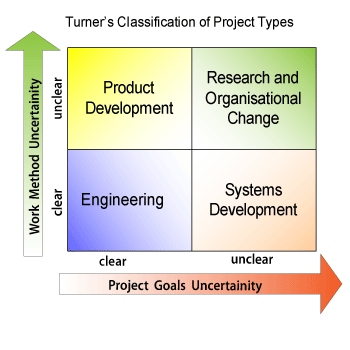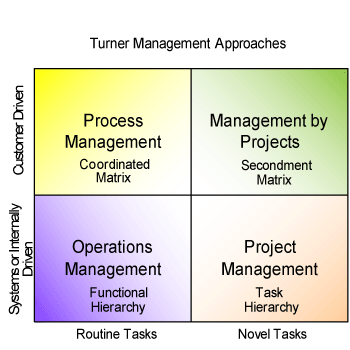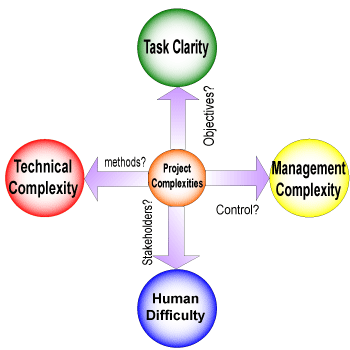Every project is unique and has a degree of complexity. It is necessary to understand the complexities early in order to derive the the appropriate management strategy and approach. This article will introduce the concept of complexities in the projects and use the defined researches to enable a project sponsor to pin point where the difficulty will arise if the project is given a 'go'........
Project Complexities and Classification
It is desirable to develop methods to classify the projects as the nature of the project will influence the approach adopted to manage the project. It is particularly important to realize when the traditional project management technique is in-appropriate and when it needs to be modified.
The two attempts have been made to classify the projects based upon the origin of difficulty:
Technical Vs Human Difficulty
D'Herbemont and Cesar (1998) has described certain projects are sensitive on the basis of the degree of technical and human difficulty. The technical difficulty involves dealing with technology and related problems such as new and innovative technology, management of technological development, risks and dependencies. While the human difficulty (usually politics)resulting from the interests of internal and external stakeholders or public, who influence the outcome of the project. The internal factors being project resourcing, conflict management and agreement of client and suppliers on what is being delivered as per contract. The external factors are impact from politics, laws and regulation, socio-economy, public opinion, market conditions and project financing.
- Technical Difficulty – The projects are technically complex due to uncertainty in technology and/or work methods and project tasks. The uncertainity in technology projects is due to the degree of R&D and innovation required or organizational change. In the case of organizational change project, the complexity will depend upon, if the change is internal or external to the organization. What is the impact of the change? Will the change deliver business benefit?
In both of these types, the project tasks would need to be defined for the short term and modified as the project develops. Such projects can be best managed using the direct-strategy, which consists of defining the scope, logically structuring the project in successive tasks, planning and controlling via tracking and reporting on the progress. The human factor will be limited to the technical skills and expertise. - Human Difficulty - The human difficulties arise when people within and outside the organization can exert significant influence on the project.
For example, a project was initiated by the Australian Government to introduce ‘Safe Injecting Rooms for Drug Users’. Although the benefit was realized as it would minimize the deaths caused by uncontrolled drug usage, but still carried enormous resistance from public, the residents of the suburbs where the rooms were launched and the opposition party. Such projects are best managed using indirect strategy, which enforces use of tactits to manage stakeholders (external and/or internal). The required approach is usually to manage the conflict such that all parties are in agreement.
Internally, the project can face resourcing problem and when the technical projects become dependent upon key people who posses certain skills that are difficult to replace if that resource quits, it becomes an identfied risk.
Another key human related issue is documenting the technical development - no one documents what they do. They just do it. It remains in their heads. This introduces point of failures in the project. A documenting culture needs to be promoted by the stakeholders to avoid these single point of failures.
Project Goals Vs Method
Rodney Turner (1999) on the other hand classifies the projects are based on two dimensions - how well defined are the goals of project and how well defined are methods of achieving those goals. Based on the above characteristics he defined four types of projects:-

- Engineering Projects: Both goals and methods are well defined making it feasible to quickly plan and execute the process; the project success is highly likely.
- Product Development: The functionality of project is well defined but methods to achieve it are poorly defined. The work methods are determined progressively as various milestones of the project are completed.
- Systems Development: The goals of product are poorly defined, since the customers have a vague idea of what they want, however there are well known methods to achieve them once the goals are known.
- Research: Both goals and methods are unclear, significant information can only be discovered at various milestones. Thus the next subtask and it’s method have to be planned at some later time. Such projects are inherently risky and are more likely to fail.
Management approaches for different tasks
Based on classification of projects, Turner defines the four management approaches requiring different styles of management:
Systems or Internally Driven Tasks
- Operations Management - The routine tasks are typically handled by the firms operations and managed by a hierarchical management system where people have well-defined continuous roles. This is typical management system found in many traditional organizations and treated at length in traditional management literature.
For example, an IT Service Organization is a function that requires day-to-day management of desktops, servers, networks, applications, internet and user related incidents. Within this organization, teams are fixed and defined roles, such as Service Managers, IT Managers, and Support Staff – 1st line, 2nd line, 3rd line, etc.
- Project Management - The unique or novel tasks are managed by project management systems which requires a greater degree of flexibility in refining people's role. These two systems to work together in an organization can be significant challenge.
For example, an upgrade to the existing email system is being proposed by the business. In order to produce a solution, a Solution Consultant/Manager will be required to interface with operations functional teams to make sure the solution produced fits in with the requirement and gain required approvals. The solution provision can be considered as a bid project. This project will have duration and also disband once the bid has been submitted and approved by the business and operations. Often, found that there are clashes between operations and projects, and conflicts are better managed by discussions, meetings and gaining approvals early and at every stage of solution development.
Customer Driven Systems
- Process Management Systems - The customer driven system is one where the customer can exert some influence on the output or product being produced. One of the systems can be process management system producing a continuous output and the customer can exert influence on the output. The tasks involved can be better handled by a coordinated matrix structure, where the production team and customer representative work together.
- Management by Projects - The unique or novel tasks are those where the customer can exercise considerable influence by interacting strongly during the entire course of a unique project. The tasks are managed by a secondment matrix, which means that functional organization (including customer organization) would allocate staff to work on the project on temporary basis.
The other areas of project complexity are:
- Project Size: The larger the project, more will be the number of people involved. This would increases the management overhead in terms of tracking progress, communication and inter-personal conflict resolvement.
- Duration: The time scale of the project determines how to limit the scope and expectations.
- Activities: The number of activities planned for the project and their dependencies.
- Budget: The financial investment required.
- Risks: Nearly all projects carry some level of risks. It is important to identify and manage those risks to save the project from failures.
The above two classifications can be summarised into the following four areas of complexity in projects. Based upon them the management strategy can be thought and adoped.

Conclusion
The project complexity shall be determined on project by project basis. This would dictate which management areas requires more focus within the project and what techniques to be used. The basic management areas in projects are as follows:
- Project Organization - How the project resources to be best applied? - What type of project structure (Matrix or Pure Project) to be used?
- Project Parameters Management - Scope, Schedule, Cost, Quality - What is the trade off?
- Project Stakeholder Management - How the stakeholders are informed and consensus gained?
- Project Risk Management - How much risk the organization is willing to take and thus how do we manage them?
- Project Change Management - What is the project boundary and how do we manage the changes in project boundary?
- Managing Quality in projects
Some of the techniques used in projects to manage complexities are:
- Work or Product Based Planning
- Project Quality Reviews
- Controlling Change
Nevertheless, you would need a project manager who is right for the project. It is appropriate to list the skills for the required project manager at this stage. For example, the project that has more of human difficulties, would need a project manager who is an attitude politician or have skills in effective people management; while the technically difficult project will require a project manager with experience in the technical domain of the project and management skills.
Further in our articles, we will articulate what skills should a the Project Manager must have......
